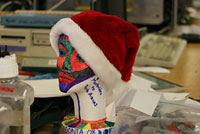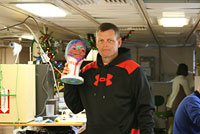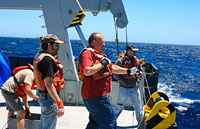

 | |||||||||||||||||
|
|
Journals 2008/2009Jeff Lawrence
December 23, 2008 Dave Drapeau is at it again. Today is our last day to be off the continental shelf where the waters are over 4,000 meters deep. The rest of the cruise will be spent along the continental slope and continental shelf where waters are not as deep. Dave brought an extra styrofoam head for me and my class, he gave it to the crew to decorate and leave messages on. After the dive is complete I get to bring it home with me, it will make a great paperweight on my desk. After the cast the styrofoam head has contracted to a much smaller size and seems much denser than before. I appreciate Dave for allowing me to have this souvenir to take home. All the people aboard the REVELLE have been extremely helpful and gracious. They have made me feel as though I am part of the team. They are always willing to answer my questions and help me gather information for my journals that I send the University of Rhode Island in Narragansett Bay. When the journals arrive at URI, Romy Pizziconi is diligently having them posted as close to real-time as possible. This allows my students to follow along closely back in Oklahoma. My students download a photo or two from the journals into a Powerpoint presentation and write a paragraph in their own words on that day's journal entry. They also answer the questions of the day posted on each journal entry. I have been able to Skype back to my classroom and visit with each science class I teach. Some video and audio Skype but most through chat, it is hard to keep a strong signal at sea with the ship moving constantly. The students have asked good questions, that I answer, or if needed I have asked one of the scientist on board to answer. Lowrey students also follow the ship's latitude, longitude, sea conditions, sky cover, and temperature via the ship's website. They keep this data on a log sheet on each of their computers. Several other classrooms are following along form Boothbay Harbor, Maine. I hope this will inspire students to look at the ocean differently with an understanding of its importance to all of us. Oklahoma is land-locked, but all of its citizens should have the same awareness of ocean conservation principles as a state like Florida, which is surrounded by ocean. The NSF (National Science Foundation) funded not only the ARMADA project through URI which allowed me to be a part of this experience, but also the research on this vessel: "Factors Controlling Coccolithophore Calcification in the Ocean." NSF funds many opportunities for teachers and researchers alike. It is nice to have programs that pair teachers with researchers. Both parties win in this combination. Teachers enjoy a valuable learning experience that they can then share with their students, which will hopefully motivate some students to seek a profession in that field, or at least give all students a better understanding of the world around them. This will enable them to be better stewards of our planet than our generation has been. The researchers receive an outlet for their research to be shared with students, parents, and even allows their own families to follow along with what is happening on the cruise. Many people on board the REVELLE have asked for the website where the journals are published so their own families can see what is happening on board. I am receiving positive feedback from some family members via email to their family member on board the REVELLE. A photo and short article may be all that they see of the family member until they arrive back home. Many of us will have been gone from home for 37 days by the end of the journey.
Today I was assisting Barney and Bruce Bowler to deploy the OCP off the fantail of the REVELLE, when a British C3 airship buzzed our ship. It swept down from the sky like a large bird, flew low and very close to the ship. The flyby caught everyone by surprise- we haven't seen any other aircraft and only an occasional freighter sails by, and very few of them. I guess they were checking up on our activity since they are still at odds with the Argentines over the Falklands. Today we are just north of the Falkland Islands. The seas are still a little rough, but nothing like Sunday. Sunday was also the summer solstice in the southern hemisphere, the longest day of the year. Due to the weather conditions and rough seas on Sunday, it felt like the longest day. Actually the day is still 24 hours long, but the sun stays out longer on this day than any other, setting around 10:20 pm local time.
Questions of the Day:
|
||||||||||||||||



